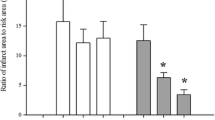Abstract
Objective
To explore the synergistic protection of Danhong Injection (丹红注射液, DHI) and ischemic postconditioning on myocardial reperfusion injury in minipigs.
Methods
Acute myocardial infarction model was made by balloon occlusion in left anterior descending coronary artery (LAD) of minipigs, and then postconditioning was simulated through inflation/deflation of the angioplasty balloon. Minipigs were divided into four groups: the sham operation group (SH group), the ischemia/reperfusion group (I/R group), the ischemic postconditioning group (POC group) and DHI combined with ischemic postconditioning group (PAD group, DHI 20 mL through ear vein), six in each group. After 24-h continuous observation, myocardial infarction size was assessed by triphenyltetrazolium staining (TTC). Morphological changes of ischemic myocardium were observed by light microscopy, and cardiomyocyte ultrastructure was studied with electron microscopy. The superoxide dismutase (SOD) and malondialdehyde (MDA) activity in heart homogenates were measured by a biochemical method.
Results
The myocardial infarction size was smaller in the POC group than in the I/R group (0.26±0.02 vs. 0.37±0.09, P<0.05), and the PAD group (0.14±0.08) displayed a significantly reduced infarction size relative to the I/R group (P<0.01) and POC group (P<0.05). The damage of myocardial tissue was severe in the I/R group shown by light and electron microscopy: myocardial fibers disorder, sarcoplasmic dissolution, myofilament fracture, mitochondria swelling and even vacuolization formation and a large number of inflammatory cell infiltrations. Compared with the I/R group, reduction of reperfusion injury in the PAD group included more orderly arranged myocardial fibers, less infiltration of inflammatory cells and maintenance of mitochondrial integrity. Compared with the I/R group, the damage of myocardial tissue in the POC group was improved, but not as significant as that in the PAD group. SOD levels in the POC group and the PAD group were significantly higher than those in the I/R group (96.96±13.43, 112.25±22.75 vs. 76.32±10.63, P<0.05), and MDA was significantly lower in the POC group and the PAD group compared to the I/R group (1.27±0.19, 1.09±0.21 vs. 1.47±0.16, P<0.05).
Conclusion
DHI and ischemic postconditioning show a synergistic cardioprotection on myocardial reperfusion injury in minipigs.
Similar content being viewed by others
References
Skyschally A, van Caster P, Iliodromitis EK, Schulz R, Kremastinos DT, Heusch G. Ischemic postconditioning: experimental models and protocol algorithms. Basic Res Cardiol 2009;104:469–483.
Downey JM, Cohen MV. Why do we still not have cardioprotective drugs? Circ J 2009;73:1171–1177.
Tissier R, Waintraub X, Couvreur N, Gervais M, Bruneval P, Mandet C, et al. Pharmacological postconditioning with the phytoestrogen genistein. J Mol Cell Cardiol 2007;42:79–87.
Feng K, Ji XB, Qiu WW, Jiang MY, Shen W, Jiang W, et al. The effect of Danhong injection on cardiovascular event in earlier period and inflammatory reaction of the patients of ACS with PCI. J Chin Microcirculation (Chin) 2007;11:390–392.
Tian ZQ, Wu L, Yi CH. Clinical observation of Danhong Injection on unstable angina pectoris. Pract J Cardioac Cereb Pneum Vasc Dis 2008;16:19–21.
Xia K, Li JB, Wu JW, Wu XH. Effects of Danhong injection on expression of ICAM-1 in rat kidneys with ischemia-reperfusion injury after renal transplantation. J Chongqing Med Univ (Chin) 2010;35:199–202.
Li XZ, Liu JX, Ren JX, Yu Z, Li L, Shi Y, et al. Establishment of coronary heart disease model of phlegm-stasis cementation syndrome type in mi ni swines. Chin J Integr Tradit West Med (Chin) 2009;29:228–232.
Zhao ZQ, Corvera JS, Halkos ME, Kerendi F, Wang NP, Guyton RA, et al. Inhibition of myocardial injury by ischemic postconditioning during reperfusion: comparison with ischemic preconditioning. Am J Physiol Heart Circ Physiol 2003;285:579–588.
Halkos ME, Kerendi F, Corvera JS, Wang NP, Kin H, Payne CS, et al. Myocardial protection with postconditioning is not enhanced by ischemic preconditioning. Ann Thorac Surg 2004;78:961–969.
Galagudza M, Kurapeev D, Minasian S, Valen G, Vaage J. Ischemic postconditioning: brief ischemia during reperfusion converts persistent ventricular fibrillation into regular rhythm. Eur J Cardiothorac Surg 2004;25:1006–1010.
Tsang A, Hausenloy DJ, Mocanu MM, Yellon DM. Postconditioning: A form of “modified reperfusion” protects the myoicardium by activating the P13k-Akt pathway. Circ Res 2004;110:161–167.
Argaud L, Gateau-Roesch O, Raisky O, Loufouat J, Robert D, Ovize M. Postconditioning inhibits mitochondrial permeability transition. Circulation 2005;111:194–197.
Hausenloy D, Wynne A, Duchen M, Yellon D. Transient mitochondrial permeability transition pore opening mediates preconditioning-induced protection. Circulation 2004;109:1714–1717.
Chen YW, Huang CF, Tsai KS, Yang RS, Yen CC, Yang CY, et al. The role of phosphoinositide 3-kinase/Akt signaling in low-dose mercury-induced mouse pancreatic beta-cell dysfunction in vitro and in vivo. Diabetes 2006;55:1614–1624.
Monassier JP. Reperfusion injury in acute myocardial infarction. From bench to cath lab. Arch Cardiovasc Dis 2008;101:491–500.
Nikolaidis LA, Mankad S, Sokos GG, Miske G, Shah A, Elahi D, et al. Effects of glucagons-like peptide-1 in patients with acute myocardial infarction and left ventricular dysfunction after successful reperfusion. Circulation 2004;109:962–965.
Zhang LN, Wu YL. Protective effect of pharmacologic postconditioning on myocardial ischemia/reperfusion injury. Progress Pharm Sci (Chin) 2008;32:157–162.
Author information
Authors and Affiliations
Corresponding author
Additional information
Supported by the National Natural Science Foundation Major Research Plan (No. 30772868)
Rights and permissions
About this article
Cite this article
Ma, Xj., Yin, Sj., Jin, Jc. et al. Synergistic protection of Danhong Injection (丹红注射液) and ischemic postconditioning on myocardial reperfusion injury in minipigs. Chin. J. Integr. Med. 16, 531–536 (2010). https://doi.org/10.1007/s11655-010-0567-0
Received:
Published:
Issue Date:
DOI: https://doi.org/10.1007/s11655-010-0567-0




